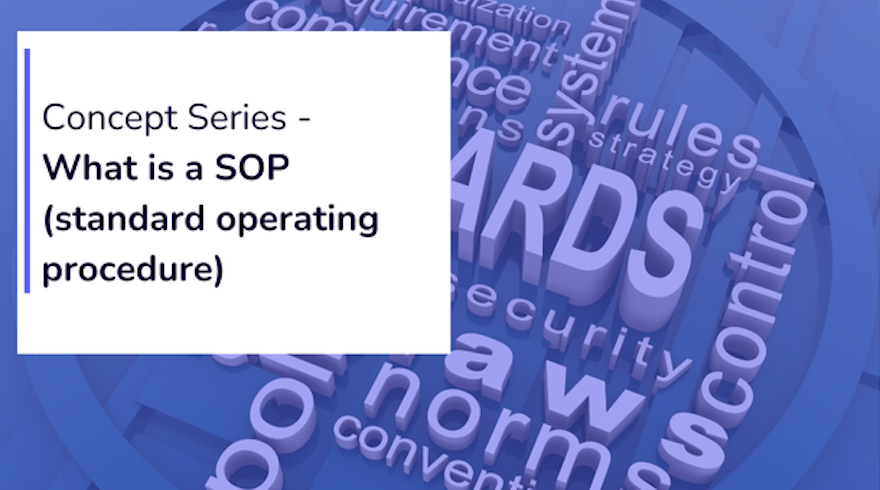Standard Operating Procedures, commonly known as SOPs, are the backbone of any well-run organization. But what exactly are SOPs, and why are they so critical to success? Whether you're a seasoned professional or just starting out, understanding SOPs is essential for ensuring consistency, quality, and compliance in your operations. In this guide, we'll dive deep into the world of SOPs, exploring their purpose, benefits, and how to create effective SOPs that can transform your business processes. Did you know that companies with well-documented SOPs experience 50% fewer errors in their operations? Let’s explore why that is and how you can leverage SOPs to boost your organizational performance.
Section 1: What is an SOP?
Definition of Standard Operating Procedures
Standard Operating Procedures (SOPs) are formal, written instructions that detail the specific steps and processes required to complete a particular task or operation within an organization. These documents are designed to ensure consistency and quality in the execution of tasks by providing clear, step-by-step guidelines that anyone can follow. SOPs are crucial in industries where precision and uniformity are critical, such as manufacturing, healthcare, pharmaceuticals, and food processing.
The History and Evolution of SOPs
The concept of SOPs can be traced back to early industrial practices, where the need for standardized processes became apparent to ensure product quality and operational efficiency. The formalization of SOPs gained momentum during the industrial revolution, as factories and production lines required uniform procedures to maintain consistency across large-scale operations. Over time, SOPs evolved to include not only production processes but also safety protocols, quality assurance, and compliance measures. Today, SOPs are an integral part of any organization’s operational strategy, reflecting advancements in technology, regulatory requirements, and best practices in business management.
Different Types of SOPs
Process SOPs:
- These outline the steps needed to complete a specific process, ensuring that every employee follows the same method, leading to consistent results. For example, a process SOP might describe the steps for assembling a product on a manufacturing line.
Safety SOPs:
- Safety SOPs are critical in industries where there are inherent risks. These documents detail the safety measures employees must follow to protect themselves and others. This can include procedures for handling hazardous materials or operating heavy machinery.
Quality SOPs:
- Quality SOPs focus on maintaining high standards in production and service delivery. They provide instructions on how to perform quality checks, how to handle defects, and how to ensure that products meet regulatory and customer standards.
Administrative SOPs:
- These SOPs govern routine administrative tasks, such as how to manage records, handle customer inquiries, or process payroll. They help ensure that back-office functions run smoothly and efficiently.
Regulatory Compliance SOPs:
- In heavily regulated industries, such as pharmaceuticals or food production, regulatory compliance SOPs are essential. These SOPs ensure that all operations are in line with governmental and industry regulations, helping to avoid legal issues and maintain certification.
Each type of SOP serves a specific purpose but shares the common goal of creating a clear, replicable process that can be followed by anyone in the organization, regardless of their level of experience.
Section 2: Why are SOPs Important?
Ensuring Consistency and Standardization
One of the primary reasons for implementing SOPs is to ensure that every task within an organization is performed consistently and according to a standardized process. Consistency is key to delivering high-quality products or services, as it minimizes variations and errors. By following SOPs, employees can carry out tasks in the same manner every time, regardless of who is performing the job. This is particularly important in industries like manufacturing, healthcare, and pharmaceuticals, where even minor deviations can have significant consequences. SOPs help maintain a uniform approach across all operations, leading to predictable and reliable outcomes.
Improving Efficiency and Productivity
SOPs streamline processes by providing clear, step-by-step instructions, reducing the time employees spend figuring out how to complete a task. This efficiency translates into higher productivity, as tasks are completed faster and with fewer errors. When employees know exactly what is expected of them and how to perform their duties, they can work more confidently and efficiently. Moreover, SOPs can identify potential bottlenecks or unnecessary steps in a process, allowing for continuous improvement and optimization of workflows. This leads to more efficient use of resources, whether human, financial, or material.
Reducing Errors and Risks
Mistakes in business operations can be costly, both in terms of finances and reputation. SOPs serve as a preventive measure by clearly outlining the correct way to perform tasks, which significantly reduces the likelihood of errors. In high-risk industries such as aviation, healthcare, and chemical production, even a small mistake can lead to disastrous consequences. SOPs mitigate these risks by providing comprehensive guidelines that help employees avoid common pitfalls. Additionally, by adhering to SOPs, organizations can ensure that safety protocols are followed, further minimizing the risk of accidents or injuries.
Enhancing Training and Onboarding Processes
Training new employees can be a time-consuming and resource-intensive process. SOPs make this process more efficient by serving as a valuable training tool. New hires can quickly get up to speed by following the detailed instructions laid out in SOPs, reducing the learning curve and enabling them to contribute to the organization sooner. SOPs also ensure that all employees receive consistent training, which is crucial for maintaining quality and performance standards. Moreover, SOPs can be used to train existing employees on new procedures or updates, ensuring that everyone in the organization is aligned and up-to-date.
Compliance with Industry Regulations
In many industries, adherence to specific regulations and standards is not just important—it’s mandatory. SOPs play a critical role in helping organizations comply with these regulations by providing documented procedures that meet industry and governmental standards. Regulatory bodies often require organizations to demonstrate that they have SOPs in place and that these SOPs are being followed consistently. Failure to comply can result in severe penalties, including fines, legal action, or loss of certification. By maintaining up-to-date and accurate SOPs, organizations can ensure they remain in compliance with all relevant regulations, thereby avoiding these risks.
Section 3: Key Elements of an Effective SOP
Creating an effective Standard Operating Procedure (SOP) involves more than just writing down steps to complete a task. An effective SOP must be clear, comprehensive, and accessible to ensure that it can be followed accurately by any employee. Below are the key elements that make up an effective SOP:
Clear Objectives and Scope
Every SOP should start with a clear statement of its objectives and scope. This section outlines the purpose of the SOP and specifies which processes or tasks it covers. Defining the scope is crucial because it sets boundaries on what the SOP addresses and helps employees understand when and where the SOP should be applied. The objective section should answer the following questions:
- What is the SOP intended to achieve?
- Which departments or functions does it apply to?
- Are there any limitations or exclusions?
By clearly defining the objectives and scope, you ensure that employees understand the relevance of the SOP to their work and when they should use it.
Detailed Step-by-Step Instructions
At the heart of any SOP are the detailed, step-by-step instructions that guide employees through the task or process. These instructions should be written in a clear, concise, and logical manner, ensuring that even someone with minimal experience can follow them. The steps should be:
- Numbered or bulleted to make them easy to follow.
- Written in simple, direct language to avoid confusion.
- Sequenced logically, with each step flowing naturally to the next.
- Inclusive of necessary details such as specific tools, materials, or software required for each step.
The goal is to leave no room for interpretation—employees should know exactly what to do at each stage of the process.
Visual Aids and Diagrams
Visual aids, such as diagrams, flowcharts, and photos, can greatly enhance the effectiveness of an SOP. Visuals help to clarify complex steps and provide a reference that can be easier to understand than text alone. For example:
- Flowcharts can map out a process, showing the sequence of steps and decision points.
- Photos or illustrations can demonstrate how to perform a specific task, such as assembling a component or operating a machine.
- Diagrams can depict the layout of equipment or workspaces, helping employees understand the physical context of the SOP.
Including visual aids ensures that the SOP is accessible to all employees, regardless of their reading or language proficiency, and can significantly reduce errors.
Defined Roles and Responsibilities
An effective SOP must clearly define the roles and responsibilities of the individuals involved in the process. This section should specify:
- Who is responsible for executing each step of the SOP.
- Who is responsible for overseeing or approving the process (e.g., supervisors or quality control personnel).
- Any specific qualifications or training required for those performing the tasks.
By clearly assigning responsibilities, the SOP helps ensure accountability and reduces the likelihood of tasks being missed or performed incorrectly.
Regular Review and Updates
SOPs are living documents that need to be reviewed and updated regularly to remain effective. Changes in technology, processes, or regulations may require updates to existing SOPs. An effective SOP should include:
- A review schedule, such as annual or biannual reviews, to ensure the SOP remains current.
- A procedure for making and documenting changes, so that updates are tracked and communicated to all relevant employees.
- Version control, with each SOP version numbered and dated to prevent confusion about which version is the most current.
Regular review and updates ensure that SOPs continue to reflect best practices and compliance with current regulations, and they help maintain their relevance and effectiveness over time.
Accessibility and Ease of Use
For an SOP to be effective, it must be easily accessible to those who need it. This means:
- Storing SOPs in a central, easily accessible location, whether digital or physical, so that employees can quickly find the SOPs they need.
- Ensuring that the SOP is written in a user-friendly format, with a clear layout, headings, and subheadings that make it easy to navigate.
- Providing the SOP in multiple formats if necessary, such as digital copies for use on mobile devices or hard copies for use in workspaces where digital access may be limited.
By making SOPs easily accessible and user-friendly, organizations can ensure that employees are more likely to use them and follow them correctly.
Section 4: How to Create an SOP: A Step-by-Step Guide
Creating an SOP that is both effective and user-friendly requires a systematic approach. The process involves careful planning, collaboration, and ongoing refinement to ensure that the final document meets the needs of the organization and its employees. Below is a step-by-step guide to developing a Standard Operating Procedure:
1. Identifying the Need for an SOP
The first step in creating an SOP is to identify the specific process, task, or operation that requires standardization. This may arise from various needs, such as:
- Compliance with regulations: Some industries mandate SOPs to ensure that operations meet legal or regulatory standards.
- Consistency in operations: SOPs help reduce variability in tasks that require precision and uniformity.
- Training and onboarding: SOPs can serve as valuable training tools for new employees or for cross-training existing staff.
- Quality improvement: Identifying areas where processes frequently encounter errors or inefficiencies can highlight the need for a formalized SOP.
Once a need is identified, it’s essential to define the scope of the SOP—detailing exactly what the SOP will cover and what it will not. This clarity prevents overlap with other procedures and ensures that the SOP is focused and relevant.
2. Gathering Relevant Information and Resources
Before drafting the SOP, it’s crucial to gather all the necessary information and resources that will inform the content. This includes:
- Input from subject matter experts (SMEs): Collaborate with individuals who have in-depth knowledge of the process. Their insights are invaluable in ensuring that the SOP is accurate and practical.
- Existing documentation: Review any existing documents, manuals, or informal procedures that pertain to the process. These can provide a foundation for the SOP and highlight areas that need improvement or formalization.
- Regulatory guidelines: Ensure that the SOP aligns with any industry-specific regulations or standards. This is particularly important in sectors such as healthcare, pharmaceuticals, and manufacturing.
- Tools and equipment: Make a list of any tools, equipment, or software required to perform the task, as these will need to be mentioned in the SOP.
This preparatory stage is critical, as it lays the groundwork for the drafting process and ensures that the SOP will be comprehensive and accurate.
3. Writing and Formatting the SOP Document
Once all the necessary information is gathered, the next step is to write the SOP. The document should be structured logically, with clear headings and subheadings to guide the reader. Here’s how to structure the SOP:
Title Page:
- The title should clearly state the purpose of the SOP.
- Include a document control number, version number, and date of creation or last revision.
- List the department or team responsible for the SOP.
Purpose and Scope:
- Clearly define why the SOP is necessary and what it covers.
- State the objectives of the SOP and the boundaries of its application.
Roles and Responsibilities:
- Detail who is responsible for each part of the process.
- Include any specific qualifications or training required for these roles.
Procedure:
- Provide step-by-step instructions, numbered or bulleted, for carrying out the task.
- Use clear, concise language, avoiding jargon unless it’s industry-specific and necessary.
- Incorporate visual aids where applicable to enhance understanding.
Safety and Compliance Considerations:
- Highlight any safety precautions that must be taken.
- Include references to regulatory compliance that are relevant to the procedure.
Review and Revision Log:
- Provide space for logging revisions, including dates, reasons for changes, and approvers.
The goal is to create a document that is easy to read, understand, and follow, even for someone with no prior experience in the task.
4. Reviewing and Testing the SOP
After the SOP is drafted, it must undergo a thorough review process before it is finalized. This review should include:
- Review by subject matter experts: Have the initial draft reviewed by SMEs to ensure technical accuracy and practicality.
- Feedback from end-users: Involve the employees who will be using the SOP in the review process. Their feedback is crucial for identifying any areas of ambiguity or difficulty.
- Compliance check: Ensure that the SOP meets all regulatory requirements and internal standards.
- Pilot testing: Implement the SOP on a small scale to test its effectiveness. This can reveal any issues with the instructions and provide an opportunity to make adjustments before full-scale implementation.
This step is essential for ensuring that the SOP is both accurate and user-friendly, minimizing the risk of errors during actual use.
5. Implementing and Training Staff
Once the SOP has been reviewed, tested, and finalized, the next step is to implement it across the relevant departments or teams. Effective implementation involves:
- Communicating the SOP: Ensure that all relevant employees are informed about the new SOP and understand its importance.
- Training sessions: Conduct training sessions to familiarize employees with the SOP. These sessions should cover the rationale behind the SOP, detailed walkthroughs of the procedures, and any safety or compliance considerations.
- Access to the SOP: Make the SOP easily accessible to all employees, whether through a digital platform or physical copies. Ensure that employees know where to find the SOP when they need it.
Proper training and communication are vital for ensuring that the SOP is followed correctly and consistently.
6. Continuous Improvement and Updates
An SOP should not be a static document. To remain relevant and effective, it must be regularly reviewed and updated. Continuous improvement involves:
- Regular reviews: Establish a review schedule (e.g., annually or biannually) to assess the SOP’s effectiveness and make any necessary updates.
- Incorporating feedback: Gather feedback from employees on the SOP’s usability and any challenges they encounter. This feedback is invaluable for making improvements.
- Documenting changes: Maintain a log of all changes made to the SOP, including the date of revision, the nature of the changes, and the reason for the update.
Continuous improvement ensures that the SOP evolves in line with changes in technology, processes, and regulations, maintaining its relevance and utility over time.
Section 5: Common Mistakes to Avoid When Developing SOPs
Creating an effective Standard Operating Procedure (SOP) is a meticulous process, but it’s easy to fall into common pitfalls that can undermine the document’s effectiveness. Avoiding these mistakes is crucial for ensuring that your SOPs are clear, actionable, and truly beneficial to your organization. Below are some of the most common mistakes made during the development of SOPs and how to avoid them:
1. Overcomplicating the Procedures
One of the most frequent mistakes in SOP development is overcomplicating the procedures. This happens when SOPs include unnecessary details, excessive jargon, or overly complex steps that make the document difficult to understand and follow. Overcomplicating SOPs can lead to confusion, errors, and non-compliance, as employees may struggle to interpret or remember the steps.
How to Avoid:
- Keep it simple: Use clear, straightforward language that is easy to understand. Avoid technical jargon unless it is absolutely necessary and widely understood by the intended users.
- Focus on essential steps: Include only the necessary steps required to complete the task. If a step doesn’t contribute to achieving the objective, consider whether it’s essential to include.
- Use short sentences and bullet points: This format is easier to read and follow than long paragraphs, especially for complex tasks.
- Test readability: Have someone unfamiliar with the process read the SOP to ensure it’s easy to understand and follow.
2. Failing to Involve Key Stakeholders
Another common mistake is developing SOPs in isolation, without involving the people who will be using them or the subject matter experts who understand the process best. This can result in SOPs that are impractical, incomplete, or not aligned with actual on-the-ground practices. It may also lead to resistance from employees who feel excluded from the process.
How to Avoid:
- Collaborate with SMEs: Engage subject matter experts in the drafting process to ensure the SOP is accurate and practical.
- Involve end-users: Seek input from the employees who will be using the SOP. Their insights can help identify potential issues and ensure that the SOP is user-friendly.
- Hold review sessions: Conduct review sessions with key stakeholders to gather feedback and make necessary adjustments before finalizing the SOP.
- Encourage a culture of participation: Make it clear that SOP development is a collaborative effort and that employee input is valued.
3. Ignoring the Importance of Regular Updates
SOPs that are not regularly reviewed and updated can quickly become outdated, leading to inefficiencies, non-compliance, and even safety risks. This is particularly problematic in industries that undergo frequent regulatory changes, technological advancements, or process improvements. An outdated SOP can cause employees to follow obsolete procedures, which can harm productivity and quality.
How to Avoid:
- Establish a review schedule: Set a regular review cycle, such as annually or biannually, to ensure that SOPs are kept up-to-date.
- Assign responsibility: Designate a person or team responsible for reviewing and updating SOPs. This ensures accountability and consistency.
- Monitor changes: Keep track of changes in regulations, technology, and internal processes that may affect the relevance of the SOP.
- Encourage feedback: Regularly solicit feedback from employees to identify areas where the SOP may need to be updated or improved.
4. Inadequate Training on the SOPs
Even the most well-written SOP will not be effective if employees are not properly trained on how to use it. Inadequate training can lead to misunderstandings, errors, and non-compliance, especially in industries where procedures are complex or require specialized knowledge. Simply distributing the SOP and expecting employees to read and understand it on their own is insufficient.
How to Avoid:
- Conduct comprehensive training sessions: Ensure that all employees who will be using the SOP are thoroughly trained on its contents. This should include both theoretical explanations and practical demonstrations.
- Use a variety of training methods: Combine different training approaches, such as workshops, hands-on practice, and e-learning, to cater to different learning styles.
- Provide ongoing support: Offer continuous support and resources, such as refresher courses or Q&A sessions, to help employees stay proficient in following the SOP.
- Test comprehension: Use assessments or quizzes to verify that employees have understood the SOP and can apply it correctly in their work.
5. Not Aligning SOPs with Business Goals
An often overlooked but critical mistake is creating SOPs that are not aligned with the organization’s broader business goals and strategies. SOPs should not only address the immediate operational needs but also support the long-term objectives of the company. Misalignment can result in procedures that are counterproductive or irrelevant, failing to contribute to the organization’s success.
How to Avoid:
- Understand the bigger picture: Before drafting an SOP, consider how the procedure fits into the organization’s overall goals. What are the desired outcomes, and how does this SOP help achieve them?
- Consult with leadership: Engage senior management in the SOP development process to ensure that the procedures align with strategic priorities.
- Set clear objectives: Define clear, measurable objectives for the SOP that reflect both the immediate process needs and the company’s long-term goals.
- Review and adjust: Regularly review SOPs to ensure they continue to align with the evolving business strategies and objectives. Adjust them as necessary to maintain this alignment.
Section 6: Best Practices for Managing and Updating SOPs
Creating an SOP is just the beginning; managing and updating these documents are critical to ensuring their ongoing effectiveness. As organizations evolve, so too must their Standard Operating Procedures to reflect changes in technology, processes, regulations, and organizational goals. Adhering to best practices in managing and updating SOPs helps maintain their relevance, accuracy, and utility. Below are the best practices to follow:
1. Setting Up a Regular Review Schedule
One of the most important aspects of SOP management is establishing a regular review schedule. Without periodic reviews, SOPs can quickly become outdated, leading to inefficiencies, errors, or non-compliance with regulations. Regular reviews ensure that SOPs are always up to date and reflective of current practices.
Best Practices:
- Determine the review frequency: Establish a review cycle based on the nature of the process and industry requirements. For example, SOPs in highly regulated industries may need to be reviewed annually or biannually, while others might be reviewed every two to three years.
- Automate reminders: Use digital tools or software to set up automated reminders for SOP reviews. This helps ensure that reviews are not overlooked due to busy schedules or turnover in staff.
- Document the review process: Create a standard procedure for reviewing SOPs that includes checking for relevance, accuracy, and compliance with any new regulations or internal changes. This ensures consistency in how reviews are conducted.
2. Involving Employees in the Review Process
Employees who use SOPs daily are often the best sources of feedback on their effectiveness. Involving them in the review and update process ensures that the SOPs remain practical and user-friendly, and it encourages a sense of ownership among staff.
Best Practices:
- Conduct feedback sessions: Regularly solicit feedback from employees on the usability and clarity of SOPs. Hold workshops or focus groups to gather their insights on what works well and what could be improved.
- Create feedback loops: Establish a formal mechanism, such as a suggestion box or digital portal, where employees can continuously provide input on SOPs. Encourage them to report issues, suggest improvements, and share best practices.
- Act on feedback: Take employee feedback seriously and implement suggested changes where appropriate. Acknowledge contributions and communicate any updates to the SOP, explaining how feedback was incorporated.
3. Using Digital Tools for SOP Management
In today’s digital age, managing SOPs using paper-based methods is increasingly inefficient and prone to errors. Digital tools offer numerous advantages for managing, storing, and updating SOPs, including easier access, version control, and the ability to track changes.
Best Practices:
- Adopt SOP management software: Use dedicated software solutions designed for SOP management. These platforms typically offer features like version control, access permissions, automated review schedules, and centralized storage.
- Ensure accessibility: Make sure that SOPs are easily accessible to all employees, regardless of their location. Cloud-based platforms allow employees to access SOPs from any device, ensuring that the most current version is always at their fingertips.
- Leverage digital collaboration tools: Utilize collaboration tools that allow multiple users to review and edit SOPs simultaneously. This is particularly useful during the review process, enabling real-time feedback and updates.
- Implement electronic signatures: For SOPs that require approvals or acknowledgments, use electronic signature tools to streamline the process and ensure a digital audit trail.
4. Ensuring Accessibility and Ease of Use
An SOP is only effective if it is easily accessible and user-friendly. Complicated documents that are difficult to find or understand can lead to errors and non-compliance. Therefore, it’s crucial to prioritize accessibility and ease of use in SOP management.
Best Practices:
- Centralize SOP storage: Store all SOPs in a single, easily accessible location, such as a shared drive, intranet, or cloud-based platform. Ensure that employees know how to access the SOPs they need.
- Use clear, intuitive naming conventions: Label SOPs in a way that makes them easy to identify and search for. For example, include the department name, process title, and version number in the file name.
- Design for readability: Format SOPs with clear headings, bullet points, and visual aids. Use a consistent structure across all SOPs to make them easy to navigate. Consider using different colors or icons to highlight important sections or safety information.
- Provide training on access and use: Train employees on how to access and use SOPs. Ensure that they understand how to navigate the SOP management system and where to find specific documents.
5. Integrating SOPs into Daily Operations
To maximize their effectiveness, SOPs should be integrated into the daily routines and operations of the organization. This ensures that SOPs are not just documents stored on a shelf but active tools that guide employees in their daily tasks.
Best Practices:
- Embed SOPs into workflows: Incorporate SOPs directly into the daily workflows and checklists that employees use. For example, link SOPs to task management systems so that employees can easily reference them as they work.
- Use SOPs in training: Make SOPs a central component of employee training programs, especially for onboarding new hires and cross-training existing staff. This helps reinforce the importance of SOPs and ensures that employees are familiar with them from the start.
- Regularly reinforce SOPs: Periodically remind employees of the importance of SOPs during team meetings, safety briefings, and performance reviews. Encourage supervisors to reference SOPs during daily operations and when addressing performance issues.
- Audit SOP compliance: Conduct regular audits to ensure that SOPs are being followed. Use audit findings to identify areas where additional training or updates to the SOP may be needed.
6. Continuously Improving SOPs
An effective SOP management system is one that allows for continuous improvement. As processes evolve, new best practices emerge, and organizational goals shift, SOPs should be regularly refined to reflect these changes. Continuous improvement ensures that SOPs remain relevant and valuable over time.
Best Practices:
- Implement a continuous improvement process: Establish a formal process for continuous improvement of SOPs. This process should include regular feedback collection, performance tracking, and a mechanism for implementing changes based on new insights or challenges.
- Encourage innovation: Foster a culture that encourages employees to suggest improvements to SOPs. Recognize and reward those who contribute valuable ideas that enhance efficiency, safety, or quality.
- Benchmark against industry standards: Regularly compare your SOPs against industry best practices and standards. This benchmarking can help identify areas where your SOPs may be lagging or where new approaches can be adopted.
- Monitor SOP performance metrics: Track key performance indicators (KPIs) related to the effectiveness of SOPs, such as error rates, compliance rates, and employee productivity. Use this data to inform decisions about updates and improvements to SOPs.
Conclusion:
SOPs are more than just documents—they are critical tools that can drive consistency, quality, and efficiency across your organization. By understanding what SOPs are and how to create them effectively, you can set your team up for success and ensure that your operations run smoothly. Ready to start implementing SOPs in your organization? Begin by identifying key processes that need standardization and start drafting your first SOP today. Remember, the key to a successful SOP is regular review and continuous improvement!
By following these best practices for managing and updating SOPs, your organization can ensure continuous improvement and operational excellence. With Speach, you can easily create, manage, and update your SOPs, making them accessible and engaging for your entire team, ensuring compliance and efficiency in every step of your processes.





